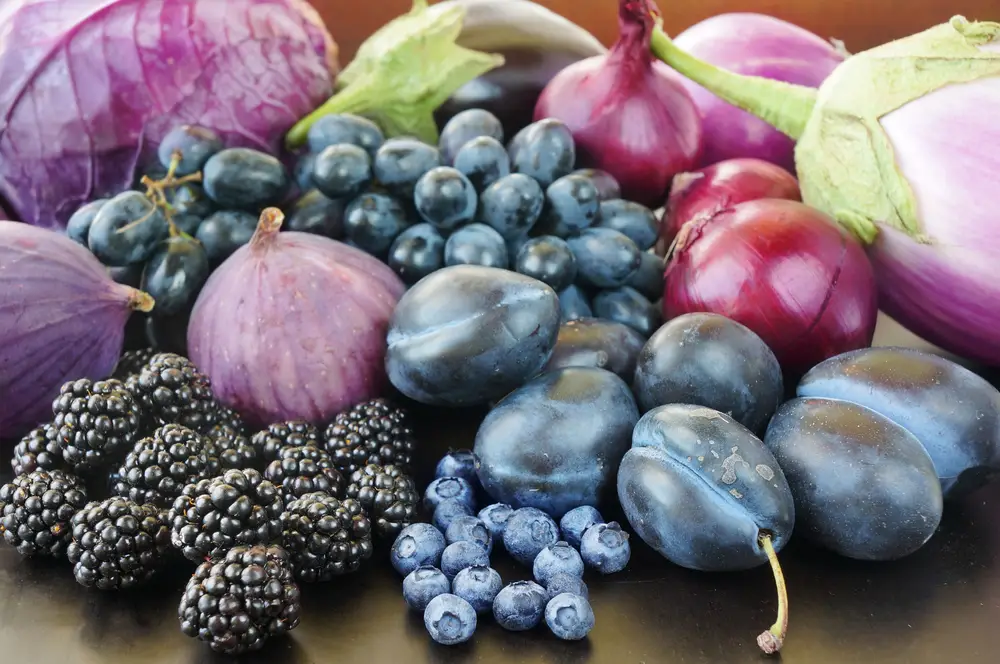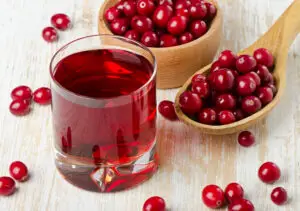Purple foods have been gaining attention for their potential health benefits and visual appeal. These vibrant coloured foods consist of various fruits, vegetables, and grains that contain a noteworthy compound called anthocyanins. These compounds not only influence the colour of the food but also provide numerous health advantages.
The diverse range of purple foods includes items such as eggplants, grapes, acai berries, blackcurrants, elderberries, purple cabbage, and purple star apples, among many others. As part of a balanced diet, it is essential to consume a variety of colours to ensure that one is receiving the full spectrum of nutrients necessary for optimal health.
Incorporating purple foods into one’s diet can contribute to overall well-being as anthocyanins, found in many of these foods, possess antioxidant properties. Moreover, the consumption of these deep red, purple, and blue fruits and vegetables promotes the idea of “eating the rainbow,” which emphasises the importance of diverse food choices for maintaining a healthy lifestyle.
Understanding Purple Foods
Purple foods comprise a wide variety of fruits, vegetables, and grains that possess a rich purple hue. These colourful foods are not only visually appealing but also pack numerous health benefits. By incorporating purple foods into one’s diet, individuals can reap the advantages of increased variety and improved nutrition.
The vibrant colour of purple foods can be attributed to the presence of anthocyanins, a type of flavonoid with antioxidant properties. These antioxidants play a critical role in protecting the body against free radicals, ultimately reducing the risk of chronic diseases, such as heart disease and certain types of cancer. Additionally, anthocyanins contribute to anti-inflammatory and anti-viral properties in the body, boosting overall health.
There are several delicious and nutritious purple foods available for consumption. Some popular options include eggplants, grapes, blackberries, purple cauliflower, and purple potatoes. These foods not only diversify one’s palate but also contribute to the concept of “eating the rainbow,” which encourages individuals to consume a vast array of colourful produce to obtain essential nutrients.
Purple foods are often considered superfoods due to their high nutritional content. For instance, purple berries like blueberries and blackberries contain significant amounts of fibre, vitamin C, and potassium, all of which promote heart health, regulate blood sugar levels, and support a healthy immune system.
Another example would be purple potatoes, which, compared to their white counterparts, boast higher levels of antioxidants and nutrients such as potassium.
Incorporating purple foods into daily meals can be as simple as adding a handful of blueberries to a breakfast smoothie or replacing traditional pasta with purple sweet potatoes. By doing so, individuals not only enhance the visual appeal of their dishes but also make strides in achieving a well-rounded, nutritious diet.
Health Benefits of Purple Foods
Antioxidant Properties
Purple foods, such as purple grapes, blackberries, and blueberries, are rich in compounds called anthocyanins. These anthocyanins not only give these foods their unique colour but also act as powerful antioxidants. They help neutralise harmful free radicals in the body, which can cause cell damage and contribute to various chronic illnesses.
Incorporating purple foods into one’s diet may help boost the body’s natural defence against oxidative stress and promote overall health.
Anti-Inflammatory Properties
Many purple foods also exhibit anti-inflammatory properties. Inflammation is a natural immune response, but chronic inflammation can be harmful and contribute to several health conditions, such as arthritis and diabetes.
Studies suggest that anthocyanins found in purple foods might help reduce inflammation by modulating the production of inflammatory molecules in the body. Therefore, consuming purple foods regularly may contribute to reducing chronic inflammation and lowering the risk of related health issues.
Heart Health
Purple foods are particularly beneficial for heart health. They help reduce several risk factors associated with heart disease, including high cholesterol and high blood pressure.
Research indicates that the anthocyanins present in purple foods can lower LDL (bad) cholesterol levels and improve blood vessel function. Additionally, their anti-inflammatory properties may also play a role in heart health by reducing inflammation in the blood vessels.
Incorporating purple foods into a balanced diet can contribute to overall heart health, reducing the risk of heart disease and other cardiovascular issues. To fully enjoy the health benefits of these colourful foods, it is essential to consume a variety of purple fruits and vegetables as part of a balanced and nutritious dietary plan.
Overview of Purple Fruits
Purple fruits come in a variety of shapes, sizes, and flavours. They are well-known for their vibrant colours, which are primarily due to the presence of anthocyanins, a type of natural pigment with antioxidant properties. This section will explore some common types of purple fruits, including berries, ube and sweet potatoes, and other purple fruits.
Berries
Berries are some of the most popular purple fruits available. They are often small, have a juicy texture, and pack a flavourful punch. Some notable examples of purple berries include:
- Acai berries: Indigenous to Central and South America, these small purple fruits are touted for their high levels of antioxidants and potential health benefits.
- Blackberries: Widespread in the northern hemisphere, blackberries are known for their tart, slightly sweet flavour, and are often used in jams, desserts, and beverages.
- Blueberries: Hailing mainly from North America and Europe, these purple-blue berries boast a rich taste and are celebrated for their antioxidant content.
- Currants: With origins in Europe and Asia, currants pack a sour or sweet taste and come in two common varieties: blackcurrants and redcurrants. The former has a deep purplish-black colour.
Ube and Sweet Potatoes
Though not fruits, ube and sweet potatoes are considered to be purple foods because of their unique and vivid purple hues. Both ube and sweet potatoes are root vegetables:
- Ube: Also known as purple yam, this vegetable comes from the Philippines and is often used in sweet dishes such as cakes or ice creams. Its natural colorant and distinctive purple shade make it a popular ingredient in desserts.
- Sweet Potatoes: Known for their sweet flavour, sweet potatoes exist in several varieties, including a purple-skinned version with white or purple flesh. These are commonly used in both sweet and savoury dishes.
Other Purple Fruits
In addition to berries, ube, and sweet potatoes, several other unique purple fruits exist. These encompass:
- Grapes: Among the world’s oldest, most diverse, and commonly consumed fruits, grapes are native to multiple regions and come in green, red, and purple varieties. They can be eaten fresh or turned into raisins, wines, and jams.
- Figs: With origins in the Mediterranean and Middle East, figs are bell-shaped fruits that have a sweet, slightly earthy taste. Their skin ranges from green to dark purple.
- Plums: Notable for their sweet and tart flavour, as well as their dark purple skin, plums are enjoyed around the world and can be eaten fresh or dried to create prunes.
- Passion fruit: A tropical fruit native to South America, passion fruit has a sweet, tangy taste, and its insides can be purple or yellow.
- Purple star apple: This fruit, found primarily in the West Indies, Central America, and Southeast Asia, features smooth, dark purple skin and a star-like pattern inside when cut open.
- Pomegranate: Hailing from the Mediterranean region and the Middle East, pomegranates are unique fruits that contain deep purple-red arils, which are small, juice-filled seeds.
These purple fruits not only add colour and flavour to our diets but also provide a range of nutrient benefits. They contribute to both our health and enjoyment in a variety of culinary applications.
Broad Spectrum of Purple Vegetables
Purple vegetables are a visually striking and nutritious part of a healthy diet. This section explores different types of purple vegetables and classifies them into three main categories: purple root vegetables, leafy purple vegetables, and other purple vegetables.
Purple Root Vegetables
Purple root vegetables are colourful, nutrient-dense underground vegetables. They include:
- Purple carrots: Rich in antioxidants, such as anthocyanins, these carrots have numerous health benefits and a sweeter taste than their orange counterparts. They can be consumed raw or cooked and might even contribute to reducing inflammation in the body.
- Beetroot: A versatile vegetable, beetroot is known for its deep purple colour and earthy flavour. It’s an excellent source of fibre, folate, and manganese, making it a valuable addition to any diet.
- Purple potatoes: Similar in flavour to regular potatoes, but with a vibrant purple hue, these potatoes are rich in antioxidants. They make a great alternative to conventional potatoes in dishes such as mashed potatoes and potato salads.
- Purple sweet potatoes: These potatoes have a unique taste and texture compared to regular sweet potatoes and are packed with additional nutrients, such as anthocyanins, which may help boost brain and heart health.
Leafy Purple Vegetables
Leafy purple vegetables are a great way to add colour and nutrients to your meals. Some popular options include:
- Red cabbage: Slightly more peppery than green cabbage, red cabbage is a flavourful addition to salads and stir-fries. It’s rich in vitamins A, C, and K, and provides antioxidants that can help protect cells from damage.
- Kale: Redbor kale, a purple variety of this popular leafy green, offers similar nutritional benefits as standard green kale but adds an eye-catching colour to your plate.
- Purple cauliflower: Containing anthocyanins, vitamin K, and vitamin C, purple cauliflower is a beautiful and healthy alternative to the common white variety, offering immune-boosting properties and brain health support.
Other Purple Vegetables
In addition to the root and leafy vegetables, there are other purple vegetables that can add vibrancy and nutrition to your meals:
- Eggplant: Also known as aubergine, eggplants are versatile and can be used in a variety of dishes, from Parmesan to curry. They are rich in dietary fibre and antioxidants, supporting good gut health and overall well-being.
- Purple asparagus: This unique variety of asparagus offers a rich source of antioxidants, vitamins A, C, and E, as well as iron and calcium. Its distinct colour and mild flavour make it an appealing addition to a wide range of dishes.
Incorporating purple vegetables into your diet not only adds visual appeal to your meals but also provides a range of essential nutrients that can contribute to better overall health.
Exploring Nutritional Value
Purple foods encompass a variety of fruits, vegetables, and grains, deriving their colour from plant pigments called anthocyanins. These foods not only add visual appeal to meals but also offer numerous health benefits due to their nutrient content.
A diet rich in purple foods provides an array of essential vitamins and minerals. For example, purple vegetables such as eggplants are an excellent source of fiber, which aids in digestion and helps maintain a healthy weight.
Similarly, purple fruits like blueberries contain high levels of vitamin C, which supports a strong immune system and healthy skin.
Moreover, purple grains, such as black rice, are packed with vital nutrients including iron, potassium, and magnesium. Iron contributes to the production of red blood cells, potassium helps regulate blood pressure, and magnesium supports muscle and nerve function.
Many purple fruits and vegetables also contain significant amounts of other essential nutrients, such as vitamin A, manganese, and folate. Vitamin A assists in maintaining good vision and a healthy immune system, while manganese plays a role in metabolism and bone formation. Folate, on the other hand, is especially beneficial for pregnant women, as it supports fetal development and helps prevent birth defects.
By incorporating a variety of purple foods into one’s diet, it is possible to obtain a well-rounded intake of essential nutrients, contributing to overall health and well-being. The unique blend of vitamins, minerals, and antioxidants found in these foods can offer potential physiological and psychological benefits, making them a valuable addition to a balanced diet.
Incorporating Purple Foods into Diet
Raw Consumption
Consuming purple foods in their raw form allows you to retain their nutritional content and enjoy their natural flavours. Fruits like blueberries, blackberries, and grapes can be eaten as snacks or added to breakfast cereals and yoghurt.
Additionally, you can incorporate raw purple vegetables, such as red cabbage, purple cauliflower, and radishes, into colourful salads or crudité platters served with dips like hummus or tzatziki.
Cooking Tips
When it comes to cooking purple foods, there are various methods you can apply to bring out their flavours and enjoy their health benefits. For instance, purple vegetables like eggplant, sweet potatoes, and carrots can be:
- Roasted: Cut them into evenly sized pieces, toss with olive oil and your favourite herbs, and roast them at 200°C (390°F) until tender and golden.
- Baked: Prepare dishes like stuffed bell peppers or casseroles featuring purple ingredients, and bake at 180°C (350°F) until cooked through.
- Steamed: Lightly steam purple vegetables until they reach the desired tenderness to retain nutrients and colour.
Remember to adjust cooking times according to the size and thickness of the ingredient in question.
In Salads and Sauces
Purple foods can add visual appeal, nutrition, and flavour to a variety of salads and sauces. A few examples include:
- Salads: Combine purple lettuce, kale, or spinach with other colourful vegetables for an eye-catching and nutritious salad. Add purple fruits like plums or pomegranate seeds for extra flavour and texture.
- Sauces: Use purple fruits to create sweet or savoury sauces that can accompany meat, fish, or vegetarian dishes. For example, a blueberry or blackberry compote can be drizzled over grilled chicken or roasted vegetables.
By integrating purple foods into your diet through these methods, you can enjoy the health benefits of these vibrant ingredients while keeping your meals diverse and delicious.
Purple Foods and Long-Term Health
Purple foods are rich in a group of plant compounds called anthocyanins, which provide a range of health benefits. These compounds are responsible for the purple pigmentation and have powerful antioxidant properties that may help protect against various diseases and promote long-term health.
Cancer: Research suggests that anthocyanins found in purple foods may help prevent cancer cell growth and reduce the risk of developing certain types of cancer. For example, purple grapes contain phytonutrients that can help protect against cancer.
Diabetes: The consumption of anthocyanin-rich foods is associated with improved insulin sensitivity and reduced inflammation, which can help in the management of type 2 diabetes. Blackberries, for instance, are an example of purple fruit that may help lower the risk of diabetes.
Stress: The potent antioxidant properties of anthocyanins can help reduce oxidative stress levels in the body. This reduction in oxidative stress may lead to better overall mental health and a decreased risk of developing stress-related disorders.
Digestive Health: The fibre content in many purple foods, such as blackberries and purple cauliflower, aids digestion and promotes healthy bowel movements. Additionally, the antioxidants in these foods may help protect the digestive tract from inflammation and damage.
Bone Health: Some purple foods, like purple potatoes, contain significant amounts of essential minerals like potassium and calcium. These minerals play a vital role in maintaining strong, healthy bones and reducing the risk of osteoporosis.
Immunity: The antioxidants in purple foods help support a strong immune system by neutralising harmful free radicals and strengthening the body’s natural defences against infections and diseases.
Eye Health: Anthocyanins found in purple fruits and vegetables, such as blueberries and purple carrots, have been shown to protect the eyes from age-related macular degeneration and other vision-related issues.
High Cholesterol: Eating a diet that includes a variety of purple foods can contribute to maintaining healthy cholesterol levels. The fibre content in these foods can help lower LDL (bad) cholesterol, while their antioxidants can help prevent oxidative damage to blood vessels.
In summary, incorporating purple foods into one’s diet can lead to numerous long-term health benefits — ranging from improved digestion and bone health to better immunity and eye health. Anthocyanin-rich purple fruits and vegetables are a powerful addition to any balanced eating plan, providing numerous advantages for long-lasting wellbeing.
The Role of Anthocyanins in Purple Foods
Anthocyanins are a group of natural plant pigments responsible for the deep red, purple, and blue colours found in many fruits and vegetables. They belong to the family of flavonoid compounds, which are water-soluble and widely recognised for their antioxidant properties.
Purple foods, such as blueberries, blackberries, elderberries, red cabbages, and purple sweet potatoes, are rich in anthocyanins. These pigments not only give these foods their vibrant colours, but also provide numerous health benefits when consumed as part of a balanced diet.
Consuming foods with anthocyanins may offer protection against chronic diseases, including cardiovascular diseases, obesity, and cancer. The antioxidant properties of anthocyanins help to neutralise free radicals – harmful molecules produced naturally in our bodies that can cause cellular damage if left unchecked. By reducing oxidative stress, anthocyanins may help to lower the risk of developing age-related conditions, such as neurodegenerative disorders.
In addition to their antioxidant effects, anthocyanins may also have anti-inflammatory, anti-microbial, and anti-carcinogenic properties. Research suggests that these compounds can help to regulate inflammatory responses in the body, potentially leading to improved immune function.
Furthermore, studies have shown that anthocyanins have the ability to inhibit the growth of certain bacteria, which can be beneficial for maintaining gut health.
Purple foods rich in anthocyanins can also provide advantages to individuals following high-fat diets. A 2017 animal study found that consuming a high-fat diet combined with anthocyanin-rich foods may reduce obesity and improve metabolic health.
In summary, purple foods owe their bright hues to the presence of anthocyanins – plant pigments with antioxidant, anti-inflammatory, and anti-microbial properties. Including these colourful foods in your diet can offer a range of health benefits, from reducing disease risk to improving gut health.
Purple Foods Around the World
In various regions across the globe, purple foods play a significant role in local diets. These vibrant and nutrient-dense edibles have their distinctive colour due to the presence of anthocyanins, natural pigments that offer numerous health benefits.
In the Mediterranean, for example, some commonly found purple foods include eggplants and grapes. Eggplants, also known as aubergines, are a staple ingredient in dishes such as ratatouille and moussaka, while grapes serve as the foundation for wine production. Besides being delicious, these purple foods boast a rich supply of antioxidants that promote overall health.
Shifting our focus to Asia, purple sweet potatoes are prevalent in the region’s cuisine. Originating from Okinawa, Japan, these nutrient-dense tubers are famed for their potential to support a long and healthy life. Okinawan centenarians are known to have a diet rich in purple sweet potatoes, which provide a wealth of vitamins and minerals, as well as the powerful antioxidant properties derived from their attractive colour.
In addition to these noteworthy examples, an extensive range of purple foods can be found throughout the world. From exotic fruits such as acai berries native to South America, to vibrant vegetables like purple cabbage and beets, these colourful ingredients not only add visual appeal but also contribute beneficial nutrients to the table.
Incorporating purple foods into one’s diet may be a valuable approach to enhance overall vitality and well-being. By exploring the culinary traditions of regions such as the Mediterranean, Asia, and Okinawa, it becomes clear that these brightly coloured fruits and vegetables have played a central role in fostering healthy and enduring communities.
Conclusion
Purple foods encompass a variety of fruits, vegetables, and grains that are known for their vibrant colour and potential health benefits. These foods owe their hue to compounds called anthocyanins, which are water-soluble and possess antioxidant properties. Some common purple foods include eggplants, grapes, beetroot, and berries.
Incorporating purple foods into one’s diet can contribute to a diverse and balanced nutritional intake. Eating a wide range of colourful fruits and vegetables has been associated with reduced risk of chronic diseases. It is always advisable to consume these foods as part of a balanced diet, which should also include other nutritious elements such as whole grains, lean proteins, and healthy fats.
While research on the health benefits of purple foods is ongoing, it is generally accepted that including diverse colours in one’s meals can be both visually appealing and nutritionally advantageous. By incorporating purple and other vibrant foods, individuals may enhance their overall health and well-being.
My name is Ellis Francis and I have been a personal fitness trainer, sports nutritionalist and health and fitness advisor for over 25 years. I am the lead health and fitness advisor at https://awellnessbody.com.







